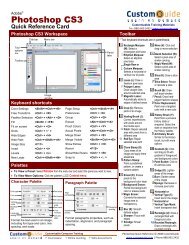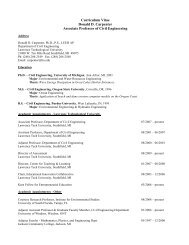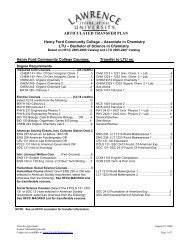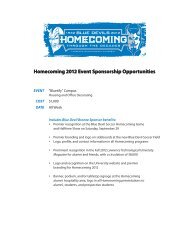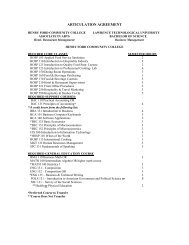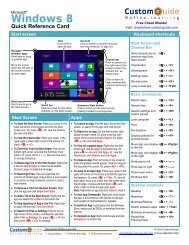Flexural Performance of Carbon Fiber-Reinforced Polymer ...
Flexural Performance of Carbon Fiber-Reinforced Polymer ...
Flexural Performance of Carbon Fiber-Reinforced Polymer ...
Create successful ePaper yourself
Turn your PDF publications into a flip-book with our unique Google optimized e-Paper software.
This paper presents the experimental investigation <strong>of</strong> the largescaleCFRP reinforced concrete bridge model. The focus <strong>of</strong> theinvestigations is to demonstrate the service state behavior and tocompare the failure behavior <strong>of</strong> the bridge model with designguidelines and numerical predictions. The bridge model, effectivespan 9.45 m (31 ft) with a width <strong>of</strong> 3.35 m (11 ft), consisted <strong>of</strong> aone-half scale 30° skewed seven box beam bridge. The bridgemodel was prestressed and reinforced with carbon fiber compositecable (CFCC). CFCCs were also used as shear reinforcement andas unbonded transverse posttensioning strands. The service stateperformance <strong>of</strong> the newly constructed bridge model with varyingtransverse posttensioning levels and number <strong>of</strong> transverse diaphragmswas evaluated from load and strain distribution tests.The effect <strong>of</strong> longitudinal deck cracks on the load distributionwas also evaluated. In addition, the effect <strong>of</strong> the bridge widthon the strain distribution is discussed by comparing results fromthis study with results available in the literature (Grace et al. 2010).Experimental InvestigationThe experimental investigation involved the construction, instrumentation,and testing <strong>of</strong> a one-half scale, 30° skewed, sevenside-by-side box beam bridge model. The seven beams were designatedB1–B7 (Fig. 1). Each box beam was reinforced with CFCCpretensioning, nonpretensioning and transverse posttensioned(TPT) strands. The box beams were 457 mm (18 in.) wide,279 mm (11 in.) deep, and 9.75 m (32 ft) long with a 127 ×254 mm ð5 × 10 in:Þ center hollow portion. The bridge modelhad five transverse diaphragms equally spaced at 1.98 m (6.5 ft)along its length. The effective span <strong>of</strong> the bridge model was9.45 m (31 ft; Fig. 2).ConstructionThe two exterior beams (B1, B7) had 30° skewed projected concretebearing at the transverse diaphragm locations. The reinforcementcages were made from eight (four top and four bottom) 1 × 7,10.5 mm (0.4 in.) nonpretensioning CFCC strands, and 9-mmdiameter(0.35 in.) CFCC stirrups (Tokyo Rope 2007). The stirrupspacing was 101.6 mm (4 in.) center-on-center between the diaphragmsand arranged according to AASHTO 6.65.12 (AASHTO2007) at the diaphragms. Each box beam was longitudinal prestressedwith three 1 × 7, 15.2 mm (0.6 in.) CFCC strands. Styr<strong>of</strong>oamblocks [ð254 mmÞ10 in: wide × ð127 mmÞ5 in: deep] were insertedinto the reinforcement cages to fill up the center hollow portion <strong>of</strong> thebox beams. The ducts <strong>of</strong> the transverse diaphragm were ellipsoidshapedaluminum tubes and were 114.3 mm (4.5 in.) wide by152.4 mm (6.0 in.) deep. This was to facilitate the passage <strong>of</strong> thetwo unbonded 1 × 7, 17.2 mm (0.7 in.) CFCC strands. Each transverseposttensioning strand was preinstalled with a threaded metalanchorage system at both ends (Fig. 3 insert) to enable varyingthe TPT forces as needed. Properties <strong>of</strong> the CFCC reinforcementare shown in Table 1.Each box beam was prestressed to 334 kN (75 kip) by using aportable hydraulic pump and jack. The prestress force in each pretensioningCFCC strand [107 kN (25 kip)/strand] was measuredusing load cells. A ready mix concrete with an average 28-dayDeck slab transverse Deck slab longitudinalreinforcement (1x7, 10.5 reinforcement (1x7, 10.5mm CFCC strands) mm CFCC strands)Top non-pretensioning(1x7, 15.2 mm CFCCstrands)Unbonded posttensioning(1x7, 17.2 mm CFCC Deck-slabstrands)Stirrups(CD 9 mmCFCC strands)3.0"(76 mm)11.0"(279 mm)B1 B2 B3 B4 B5 B6 B76.0"(152 mm)4"x6" ellipsoid shapedconduit for transverseposttensioning18"Bottom(457 mm)pretensioning(1x7, 15.2 mm CFCC strands)1" (25 mm)Shear-key11'(3.35 m)Bottom non-pretensioning(1x7, 15.2 mm CFCC strands)Fig. 1. Cross section <strong>of</strong> seven box beam bridge modelTransverse posttensioning(1x7, 17.2 mm CFCC strand)Top non-pretensioning(1x7, 10.5 mm CFCC strand)Deck-slab reinforcement(1x7, 10.5 mm CFCC strands5" x 10" (157 x 254 mm)Styr<strong>of</strong>oam14"(356 mm)6" Bottom pretensioning Stirrups @ 4" (102 mm) spacing 4.5" x 6" (114 x Stirrups @ 2" (51 mm) spacing 6"(152 mm) (1x7, 15.2 mm CFCC strands) (CD 9 mm CFCC bar)(CD 9 mm CFCC bar) (152 mm)30" 78" 78"78" 78" 30"(762 mm) (1981 mm) (1981 mm) (1981 mm) (1981 mm) (762 mm)31'(9.45 m)Fig. 2. Longitudinal section <strong>of</strong> the box beam664 / JOURNAL OF COMPOSITES FOR CONSTRUCTION © ASCE / SEPTEMBER/OCTOBER 2011Downloaded 18 Nov 2011 to 198.111.39.24. Redistribution subject to ASCE license or copyright. Visit http://www.ascelibrary.org
Fig. 4. Schematic arrangement <strong>of</strong> strain gauges on the deck slabTestingFig. 3. Completed side-by-side box beam bridge model (photocourtesy <strong>of</strong> Center for Innovative Materials Research, LawrenceTechnological Univ.)compressive strength <strong>of</strong> 49 MPa (7,100 psi) was used to constructthe beams.The seven precast box beams were placed side-by-side with a38.1 mm (1.5 in.) gap between each beam. Grout mixed, from FiveStar Structural Concrete (Five Star Products, Inc., Fairfield, CT) wasplaced in the gap to form the shear-keys. Two unbonded CFCC TPTstrands were then passed through each diaphragm. An initial TPTforce <strong>of</strong> 44.5 kN (10 kips) per diaphragm was applied to hold thebeams in place during placement <strong>of</strong> the 76.2 mm (3 in.) deck slab.The CFCC nonpretensioning reinforcement grid for the deck slabwas tied to the stirrups projecting from the precast beams. The deckslab was constructed from a ready mix concrete with an average28-day compressive strength <strong>of</strong> 41 MPa (6,000 psi). The completedbridge model is shown in Fig. 3.InstrumentationThe bridge model was instrumented for the load and strain distributiontest and the flexural test. Linear motion transducers (LMTs)were installed under each <strong>of</strong> the seven beams at the midspan <strong>of</strong> thebridge. Several strain gauges were installed on the deck slab in agrid as shown in Fig. 4. InFig.4, gridlines A–F indicate the longitudinalaxes along the shear keys. Gridlines 1, 3, and 5 indicatethe 30° skewed axis along the center, quarter, and end-span transversediaphragms. Gridlines 2 and 4 are midway between thetransverse diaphragms parallel to gridlines 1, 3, and 5. Also, straingauges were installed on the internal CFCC strands at the midspan.Load cells were placed at the dead end <strong>of</strong> each CFCC posttensioningstrand.Load and Strain Distribution Test <strong>of</strong> the Bridge ModelThe load and strain distribution tests were conducted to quantify thedifference in the load and strain response when applying differentlevels <strong>of</strong> TPT force at the diaphragms. The TPT force levels appliedwere 445, 356, 267, 178, 89 and 0 kN (100, 80, 60, 40, 20, and0 kip). Also, at a constant TPT force <strong>of</strong> 445 kN (100 kip), thenumber <strong>of</strong> transverse diaphragms posttensioned were varied from5, 4, 3 to 0. The investigations were conducted with two differentdeck configurations; the uncracked deck slab and the deck slabexperiencing longitudinal cracks along the shear keys. The crackingprocess involved saw-cutting a 12.7-mm (0.5-in.) deep notch inthe deck along the length <strong>of</strong> each shear key. A vertical load wasapplied at the midspan <strong>of</strong> the exterior beam B7 whereas the remainingbeams were restrained (Fig. 5). The load was removed once thelongitudinal crack propagated from the notch through the full depth<strong>of</strong> the shear key. The process was repeated by applying the verticalload on the next interior box beam, B6, and restraining the remainingadjacent beams (B1–B5).The load-distribution test was conducted by applying a verticalload <strong>of</strong> 133 kN (30 kip), less than the analytical bridge-crackingload <strong>of</strong> 151 kN (34 kip), at the midspan <strong>of</strong> each <strong>of</strong> the sevenbox beams and by measuring the associated beam deflections.During the strain-distribution test, the strains on the surface <strong>of</strong>the bridge deck over the shear-key joints were obtained. This testinvolved applying the TPT forces at the diaphragms while the deckslab was intact without applying the vertical loads.Ultimate-Load Test <strong>of</strong> the Bridge ModelThe ultimate flexural load test concluded the experimental test program.The following characteristics were evaluated: cracking load,ultimate load, mode <strong>of</strong> failure, and the associated behavior <strong>of</strong> theCFCC reinforcement. A spreader beam was utilized at midspan todistribute the load across the width <strong>of</strong> the simply supported bridgemodel. A 889.6 kN (200 kip) capacity actuator was used. Beforethe test, all transverse diaphragms were posttensioned to 445 kNTable 1. Information Provided by Vendor Tokyo RopePropertyDesignation1 × 7, 10.5 strands 1 × 7, 15.2 strands 1 × 7, 17.2 strands CD 9 barNominal diameter, mm (in.) 10.5 (0.41) 15.2 (0.60) 17.2 (0.68) 9.0 (0.35)Cross-sectional area, mm 2 (in 2 ) 57.8 (0.09) 115.6 (0.18) 151.1 (0.23) 57.8 (0.09)Guaranteed breaking load, kN (kip) 104 (23.4) 270 (60.7) 350 (78.7) 104 (23.4)Tensile strength, kN=mm 2 (ksi) 2.69 (390) 2.56 (371) 2.71 (393) 2.46 (357)Tensile modulus, kN=mm 2 (ksi) 162 (23,496) 157 (22,771) 156 (22,626) 169 (24,511)Elongation, (%) 1.7 1.6 1.7 1.5JOURNAL OF COMPOSITES FOR CONSTRUCTION © ASCE / SEPTEMBER/OCTOBER 2011 / 665Downloaded 18 Nov 2011 to 198.111.39.24. Redistribution subject to ASCE license or copyright. Visit http://www.ascelibrary.org
(100 kip) force. The bridge was subjected to incremental staticcycles <strong>of</strong> 111, 156, 222, 334, and 378 kN (25, 35, 50, 75, and85 kip) to determine the cracking load and the elastic and inelasticdeformations. After the quasi-static load cycle test, the bridgemodel was loaded until failure.Numerical AnalysisFig. 5. Creating longitudinal deck cracks on the bridge model (photocourtesy <strong>of</strong> Center for Innovative Materials Research, LawrenceTechnological Univ.)The ultimate failure load observed from the experimental investigationwas compared with the numerically predicted loadin a 3-dimensional (3D) finite-element analysis (FEA) <strong>of</strong> the bridgemodel. The s<strong>of</strong>tware package ABAQUS (2008) was used. The boxbeams <strong>of</strong> the bridge and the deck slab were modeled with 8-nodebrick elements (C3D8R). The pretensioned and nonpretensionedCFCC strands were modeled by using 2-node linear 3D truss elements(T3D2). The bridge model was meshed with a maximummesh size <strong>of</strong> 102 mm (4 in.) and shown in Fig. 6. The longitudinalpretensioned and the TPT forces were applied as concentratedforces at the ends <strong>of</strong> the pretensioned strands and at the bearingplates located by each transverse diaphragms, respectively.Fig. 6. Finite-element mesh <strong>of</strong> the bridge modelFig. 7. Deflection response <strong>of</strong> the bridge model with beam B4 loaded–varying TPT level666 / JOURNAL OF COMPOSITES FOR CONSTRUCTION © ASCE / SEPTEMBER/OCTOBER 2011Downloaded 18 Nov 2011 to 198.111.39.24. Redistribution subject to ASCE license or copyright. Visit http://www.ascelibrary.org
The elastic behavior <strong>of</strong> the concrete and the CFCC reinforcementswere defined by their modulus <strong>of</strong> elasticity andPoisson’s ratio. Concrete exhibits both elastic and inelastic behaviorduring loading; the inelastic behavior is complex becauseit involves modeling <strong>of</strong> the cracking behavior, compression hardening,and tension s<strong>of</strong>tening <strong>of</strong> the concrete. The “ConcreteDamaged Plasticity” model available in the s<strong>of</strong>tware packagewas used.Results and DiscussionLoad DistributionTypical results <strong>of</strong> the load-distribution test are presented in Figs. 7and 8. The general results obtained from the test are discussedsubsequently.Effect <strong>of</strong> Varying TPT Force LevelThe effect <strong>of</strong> varying the TPT force level on the bridge model wasinsignificant when the bridge deck was uncracked. A constant deflection<strong>of</strong> 5.33 mm (0.21 in.) was observed in each loaded beamand unloaded adjacent beams at all TPT force levels. For thecracked deck slab, a significant effect <strong>of</strong> the TPT force levelwas observed. When the force was increased from 0–178 kN(0–40 kip), a decrease in overall bridge deflection was observed.Yet, increasing the force beyond 178 kN (40 kip) up to 445 kN(100 kip) did not result in any significant change in the deflectionresponse.The full-depth shear keys and the deck slab were effective indistributing the single point load equally to all the beams whenthe bridge experiences no longitudinal deck cracks. However, oncecracking occurs, increasing the TPT force level improved the distribution<strong>of</strong> the applied load to all the beams and increased theflexural stiffness <strong>of</strong> the bridge model.Fig. 8. Deflection response <strong>of</strong> bridge model with beam B4 loaded–number <strong>of</strong> diaphragmsFig. 9. Strain distribution on the box beam bridge model at 100 and 40 kipJOURNAL OF COMPOSITES FOR CONSTRUCTION © ASCE / SEPTEMBER/OCTOBER 2011 / 667Downloaded 18 Nov 2011 to 198.111.39.24. Redistribution subject to ASCE license or copyright. Visit http://www.ascelibrary.org
Effect <strong>of</strong> Varying the Number <strong>of</strong> Transverse DiaphragmsThe effect <strong>of</strong> varying the number <strong>of</strong> transverse diaphragms posttensionedfrom 5, 4, 3, to 0 on the load distribution was insignificantwhen the bridge deck remained uncracked. The same deflection <strong>of</strong>approximately 5.33 mm (0.21 in.) was observed in each loadedbeam when the number <strong>of</strong> diaphragms was varied. After crackswere induced, the deflection <strong>of</strong> the loaded beam B4 (Fig. 8)was 10.41 mm (0.41 in.) when none <strong>of</strong> the diaphragms were posttensioned.Increasing the number <strong>of</strong> posttensioned diaphragms tothree or four significantly decreased the deflection in beam B4 to8.64 mm (0.34 in.). Increasing the number <strong>of</strong> diaphragms to fiveresulted in a slight decrease in beam B4’s deflection to 7.87 mm(0.31 in.). When TPT forces were applied, the deflections <strong>of</strong> theloaded and unloaded beams were almost equal and showed aneffective distribution <strong>of</strong> load in the bridge model. Yet, a slightreduction was seen in deflection when increasing the number <strong>of</strong>diaphragms posttensioned to five. The increase in the number<strong>of</strong> transverse posttensioned diaphragms increased the lateralconfinement and improved the monolithic behavior <strong>of</strong> thebridge model.Strain DistributionTypical results from the strain-distribution tests are presented inFigs. 9–11. The results are compared with the AASHTO LRFD(2007) minimum transverse prestress limit <strong>of</strong> 1.7 MPa (250 psi).This is equivalent to a minimum strain <strong>of</strong> 60με for thisbridge model.At all TPT force levels, the transverse compressive strains werehighest above the outermost shear keys. The compressive straindecreased toward the center <strong>of</strong> the deck slab. Also, compressiveFig. 10. Strain distribution on the bridge model with 4 diaphragms posttensionedFig. 11. Strain distribution on the bridge model with 3 diaphragms posttensioned668 / JOURNAL OF COMPOSITES FOR CONSTRUCTION © ASCE / SEPTEMBER/OCTOBER 2011Downloaded 18 Nov 2011 to 198.111.39.24. Redistribution subject to ASCE license or copyright. Visit http://www.ascelibrary.org
strains were observed only near the active transverse diaphragmsand decreased to almost zero midway between the posttensioneddiaphragms. This showed that posttensioning at the transversediaphragms does not generate a uniform transverse compressionstate in the deck. An increase in the TPT force level from89–445 kN (20–100 kip) resulted in a corresponding increase inthe transverse strain on the bridge deck from 39με to 92με.However, the change in maximum strain when increasing theTPT level from 356–445 kN (80–100 kip) was insignificant.Effect <strong>of</strong> Bridge Width on Strain DistributionA comparison was made <strong>of</strong> the strain distribution in a narrow-widthbridge with that in a wider-width bridge. Transverse straindistributionresults <strong>of</strong> this seven box beam bridge (wider-width),at a TPT level <strong>of</strong> 356 kN (80 kip) applied to all five diaphragms,was compared with a previous study involving a four-box beambridge (narrow-width) with similar configuration and diaphragmarrangement (Grace et al. 2010). In the case <strong>of</strong> the four-beambridge, a transverse strain <strong>of</strong> 192με was observed along the exteriorFig. 12. Load versus deflection response <strong>of</strong> the box beam bridge modelFig. 13. Failure mode detail <strong>of</strong> the box beam bridge model (photo courtesy <strong>of</strong> Center for Innovative Materials Research, Lawrence TechnologicalUniv.)JOURNAL OF COMPOSITES FOR CONSTRUCTION © ASCE / SEPTEMBER/OCTOBER 2011 / 669Downloaded 18 Nov 2011 to 198.111.39.24. Redistribution subject to ASCE license or copyright. Visit http://www.ascelibrary.org
Fig. 14. Load versus strain response <strong>of</strong> the pretensioned and nonpretensioned CFCC strandsshear key (gridline A) at the midspan diaphragm. The correspondingstrain along the exterior shear key (gridline A) <strong>of</strong> the sevenbeambridge was 90:3με. Less transverse strains developed onthe wider-width, side-by-side, box beam bridge deck comparedwith the narrow-width bridge. The wider-width bridge providedmore resistance to the transverse prestress, hence, reducing thetransverse strains on the bridge deck. In general, transverse strainson the deck slab <strong>of</strong> both bridge models were nonuniform and localizedat the diaphragms.Ultimate Load Test <strong>of</strong> the Bridge ModelAfter the load and strain distribution test, the bridge modelwas subjected to 111, 156, 222, 334, and 378 kN (25, 35, 50,75, and 85 kip) quasi-static load cycle tests. After the cycle loading,the bridge was loaded at a constant load rate <strong>of</strong> 9 kN=min(2 kip= min) until failure. Cracks were initiated at the midspan<strong>of</strong> the box beam bridge and propagated toward the deckslab as the load increased. The crack widths ranged from0.051–0.251 mm (0.002–0.010 in.). At failure, the cracks werealmost vertical and concentrated within the middle half-span <strong>of</strong>the bridge. The observed cracking load <strong>of</strong> the bridge was176.1 kN (39.6 kip) as shown in Fig. 12, and compared well withthe predicted cracking load <strong>of</strong> 151.2 kN (34.0 kip) according to theACI design guide 440.4R-04 (ACI 2004) and the FEA predictedcracking load <strong>of</strong> 178.3 kN (40.1 kip). The ultimate load <strong>of</strong> thebridge model was 718.8 kN (161.6 kip). The ACI design guideand the FEA predictions were 757.1 kN (170.2 kip) and 709 kN(159.4 kip), respectively. The deflection <strong>of</strong> the bridge at failurewas 256.5 mm (10.1 in.).The failure mode <strong>of</strong> the bridge model was compressioncontrolledand confirmed the predicted failure mode <strong>of</strong> ACI440.4R-04, 3.4.1.2 (2004) in which the reinforcement ratio(0.39%) was greater than the balanced ratio (0.22%). At failure,the concrete crushed whereas the CFCC pretensioned and nonpretensionedstrands remained undamaged as shown in Fig. 13.All the CFCC pretensioned and nonpretensioned strands exhibiteda linear behavior throughout the flexural test as shown inFig. 14. The strains in the pretensioned CFCC strands ranged from9,120–10;336με. The ultimate strain is 16;000με for the CFCCpretensioned strands. The maximum strain observed at failure inthe bottom nonpretensioned CFCC strands was 3;542με, and thecorresponding strain in the top nonpretensioned CFCC strandswas 1;448με. The ultimate strain <strong>of</strong> the CFCC nonpretensionedstrands is 17;000με. All the CFCC strands remained intact andundamaged at bridge failure as designed. The measured compressivestrain <strong>of</strong> the concrete near the location <strong>of</strong> crushing on the deckslab was 2;228με. During the test, no significant change in theTPT force level <strong>of</strong> 445 kN (100 kip) was observed, and the unbondedTPT strands remained undamaged at the failure <strong>of</strong> thebridge model.ConclusionsThe following conclusions are drawn from the investigations conductedon the one-half scale, 30°-skewed, seven box beam bridgemodel reinforced with CFCC bonded pretensioned and nonpretensionedand also unbonded transverse posttensioned reinforcement:• The bridge model behaved as expected during flexural crackingand ultimate load tests. The experimental results were in goodagreement with the predicted results according to ACI 440.1R-06 (2006) and numerical analysis.• The behavior <strong>of</strong> the bonded pretensioned and nonpretensionedCFCC strands was linear throughout the load tests. Also, theTPT CFCC strands remained intact throughout failure.• The application <strong>of</strong> the appropriate TPT arrangement was successfulin limiting the differential deflection between the boxbeams in the bridge model. This demonstrates that the load distributioncan be restored on bridges with a 30° skew angle, evenwhen longitudinal cracks exist.• The TPT forces applied at the transverse diaphragms causedlocalized transverse strains on the deck slab near the transversediaphragm over the outer beams. AASHTO’s (2007) recommendeduniform stress level <strong>of</strong> 1.7 MPa (250 psi) owing totransverse prestressing was not achieved.• Finally, a wider-width bridge (this study), compared with anarrow-width bridge in a recent study, provided more resistanceduring transverse posttensioning. Hence, bridge width appearsto be a dependent factor in the choice <strong>of</strong> the appropriate TPTforce level.670 / JOURNAL OF COMPOSITES FOR CONSTRUCTION © ASCE / SEPTEMBER/OCTOBER 2011Downloaded 18 Nov 2011 to 198.111.39.24. Redistribution subject to ASCE license or copyright. Visit http://www.ascelibrary.org
AcknowledgmentsThe research presented in this paper was made possible by supportfrom the Michigan Economic Development Corporation (MEDC)contract No. 06-1-P1-450 and the Center for Innovative MaterialsResearch (CIMR) at Lawrence Technological University.ReferencesAASHTO. (2007). “LRFD bridge design specification.” Washington, DC.ABAQUS 6.9 [Computer s<strong>of</strong>tware]. (2008). Simulia Inc., Providence, RI.American Concrete Institute (ACI) Committee 440. (2004). “Prestressingconcrete structures with FRP tendons.” ACI 440.4R-04, FarmingtonHills, MI.American Concrete Institute (ACI) Committee 440. (2006). “Guide for thedesign and construction <strong>of</strong> structural concrete reinforced with FRPbars.” ACI 440.1R-06, Farmington Hills, MI.Barr, P., Eberhard, M., and Stanton, J. (2001). “Live-load distributionfactors in prestressed concrete girder bridges.” J. Bridge Eng., 6(5),298–306.Benmokrane, B., Chaallal, O., and Masmoudi, R. (1996). “<strong>Flexural</strong> response<strong>of</strong> concrete beams reinforced with FRP reinforcing bars.”ACI Struct. J., 93(1), 46–65.Burke, C. R., and Dolan, C. W. (2001). “<strong>Flexural</strong> design <strong>of</strong> prestressedconcrete beams using FRP tendons.” PCI J., 46(2), 76–87.Csagoly, P. (1997). “Testing <strong>of</strong> a composite steel-concrete bridge deck.”Concr. Int., 19(2), 47–53.Frosch, R. J., Blackman, D. T., and Radabaugh, R. D. (2003). “Investigation<strong>of</strong> bridge deck cracking in various bridge superstructure systems.”Rep. No. FHWA/IN/JTRP-2002/25, Indiana Dept. <strong>of</strong> Transportation(INDOT), Indianapolis.Grace, N. F., Enomoto, T., Abdel-Sayed, G., Yagi, K., and Collavino, L.(2003). “Experimental study and analysis <strong>of</strong> a full-scale CFRP/CFCCdouble-tee bridge beam.” PCI J., 48(4), 120–139.Grace, N. F., Jensen, E. A., Enomoto, T., Matsagar, V. A., Soliman, E. M.,and Hanson, J. O. (2010). “Transverse diaphragms and unboundedCFRP post-tensioning in box-beam bridges.” PCI J., 55(2), 1–14.Grace, N. F., Navarre, F., Nacey, R., Bonus, W., and Collavino, L. (2002).“Design-construction <strong>of</strong> Bridge Street Bridge—First CFRP bridge inthe United States.” PCI J., 47(5), 20–35.Li, C. Q., Yang, Y., and Melchers, R. E. (2008). “Prediction <strong>of</strong> reinforcementcorrosion in concrete and its effects on cracking and strengthreduction.” ACI Mater. J., 105(1), 3–10.Moll, E. (1984). “Investigation <strong>of</strong> transverse stressing in bridge decks.”M.Sc. thesis, Dept. <strong>of</strong> Civil Engineering, McMaster Univ., Hamilton,Ontario, Canada.Poston, R., Breen, J., and Carrasquillo, R. (1989). “Design <strong>of</strong> transverselyprestressed concrete bridge decks.” PCI J., 34(5), 68–109.Rizkalla, S., and Tadros, G. (2003). “FRP for prestressing <strong>of</strong> concretebridges in Canada.” Field application <strong>of</strong> FRP reinforcement: Casestudies, SP 215, ACI, Farmington Hills, MI, 75–82.Stone, D., Prota, A., and Nanni, A. (2002). “Deflection assessment <strong>of</strong> anFRP-reinforced concrete bridge.” Deflection control for the future, ACI,Farmington Hills, MI, 1–23.Thériault, M., and Benmokrane, B. (1998). “Effect <strong>of</strong> FRP reinforcementratio and concrete strength on flexural behavior <strong>of</strong> concrete beams.”J. Compos. Constr., 2(1), 7–16.Tokyo Rope Manufacturing Co., Ltd. (2007). CFCC Quality Rep., Tokyo.JOURNAL OF COMPOSITES FOR CONSTRUCTION © ASCE / SEPTEMBER/OCTOBER 2011 / 671Downloaded 18 Nov 2011 to 198.111.39.24. Redistribution subject to ASCE license or copyright. Visit http://www.ascelibrary.org



